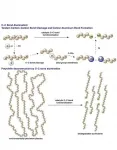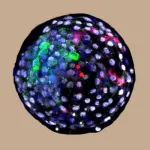Plastics could see a second life as biodegradable surfactants
2021-04-15
(Press-News.org) Scientists at the Institute for Cooperative Upcycling of Plastics (iCOUP), an Energy Frontier Research Center led by Ames Laboratory, have discovered a chemical process that provides biodegradable, valuable chemicals, which are used as surfactants and detergents in a range of applications, from discarded plastics. The process has the potential to create more sustainable and economically favorable lifecycles for plastics.
The researchers targeted their work on the deconstruction of polyolefins, which represents more than half of all discarded plastics, and includes nearly every kind of product imaginable-- toys, food packaging, pipe systems, water bottles, fabrics, shoes, cars, and furniture.
"Plastics, and especially polyolefins, are materials you could call too successful," said iCOUP Director Aaron Sadow. "They are fantastic-- strong, lightweight, thermally stable, chemically resistant-- for all the applications that we use them for, but the problem comes when we don't need them anymore."
It's all in the chemical construction of polyolefin plastics that makes them so tough and durable-- long strong chains of carbon-carbon bonds-- that also makes them hard to break down. Polyolefins also generally lack the chemical groups which could be targeted in deconstruction processes. Many existing processes to recycle plastic result in less-valuable, less usable components, making the economic feasibility of recycling far less appealing.
The new process uses what science already knows about key steps of polymerization-- the assembling of long polymer strands-- but in reverse, by breaking some of the carbon-carbon bonds in the chains. Once a few carbon-carbon bonds are broken, the shortened polymer chains transfer to an aluminum end group to form reactive species. The catalysts and reactions for this new process are related to those used in alkene polymerization, leveraging well-understood catalytic chemistry. Finally, the intermediates of this new transformation are easily converted into fatty alcohols or fatty acids, or used in other synthetic chemistry, to create chemicals or materials that are valuable in a whole host of ways: as detergents, emulsifiers, pharmaceuticals, and cosmetics. Because the process is catalytically controlled, desirable product chain lengths can be targeted for synthesis.
The best part about the process is that its end products are biodegradable, unlike polyethylene and polypropylene starting materials.
"Fatty acids and alcohols biodegrade in the environment relatively quickly. If these byproducts go on to find a new use elsewhere, that's wonderful, but it also has an end of life, which means it won't accumulate in the environment as plastics have," said Sadow.
INFORMATION:
The research is further discussed in the paper, "Catalytic Carbon-Carbon Bond Cleavage and Carbon-Element Bond Formation Gives New Life for Polyolefins as Biodegradable Surfactants," authored by Uddhav Kanbur, Guiyan Zang, Alexander L. Paterson, Puranjan Chatterjee, Ryan A. Hackler, Massimiliano Delferro, Igor I. Slowing, Fréderic A. Perras, Pingping Sun, Aaron D. Sadow; and published in Chem.
The research was conducted by the Institute for Cooperative Upcycling of Plastics (iCOUP), led by Ames Laboratory. iCOUP is an Energy Frontier Research Center consisting of scientists from Ames Laboratory, Argonne National Laboratory, UC Santa Barbara, University of South Carolina, Cornell University, Northwestern University, and the University of Illinois Urbana-Champaign.
Ames Laboratory is a U.S. Department of Energy Office of Science national laboratory operated by Iowa State University. Ames Laboratory creates innovative materials, technologies and energy solutions. We use our expertise, unique capabilities and interdisciplinary collaborations to solve global problems. DOE's Office of Science is the single largest supporter of basic research in the physical sciences in the United States, and is working to address some of the most pressing challenges of our time. For more information, please visit science.energy.gov.
[Attachments] See images for this press release:

ELSE PRESS RELEASES FROM THIS DATE:
2021-04-15
A new review published in EPJ H by Clara Matteuzzi, Research Director at the National Institute for Nuclear Physics (INFN) and former tenured professor at the University of Milan, and her colleagues, examines almost three decades of the LHCb experiment - from its conception to operation at the Large Hadron Collider (LHC) - documenting its achievements and future potential.
The LCHb experiment was originally conceived to understand the symmetry between matter and antimatter and where this symmetry is broken - known as charge conjugation parity (CP) violation. Whilst this may seem like quite an obscure area of study, it addresses one of the Universe's most fundamental questions: how it came to be dominated ...
2021-04-15
As the world's energy demands grow, so too does growing concern over the environmental impact of power production. The need for a safe, clean, and reliable energy source has never been clearer. Fusion power could fulfil such a need. A review paper published in EPJ H examines the 6-decade history of neutral particle analysis (NPA), developed in Ioffe Institute, Saint Petersburg, Russia, a vital diagnostic tool used in magnetic plasma confinement devices such as tokamaks that will house the nuclear fusion process and generate the clean energy of the future.
As ...
2021-04-15
Investigators in China and the United States have injected human stem cells into primate embryos and were able to grow chimeric embryos for a significant period of time--up to 20 days. The research, despite its ethical concerns, has the potential to provide new insights into developmental biology and evolution. It also has implications for developing new models of human biology and disease. The work appears April 15 in the journal Cell.
"As we are unable to conduct certain types of experiments in humans, it is essential that we have better models to more accurately study and understand human biology and disease," says senior author Juan Carlos Izpisua Belmonte, a professor in the Gene Expression ...
2021-04-15
LA JOLLA--(April 15, 2021) The ability to grow the cells of one species within an organism of a different species offers scientists a powerful tool for research and medicine. It's an approach that could advance our understanding of early human development, disease onset and progression and aging; provide innovative platforms for drug evaluation; and address the critical need for transplantable organs. Yet developing such capabilities has been a formidable challenge.
Researchers led by Salk Professor Juan Carlos Izpisua Belmonte have now come one step closer toward this goal by demonstrating a new integration of human cells into animal tissue. Published in the journal Cell on April 15, 2021, the new study builds upon previous work by the Izpisua Belmonte lab to take the next step in chimeric ...
2021-04-15
Illustration
A lot of attention has been paid in recent years to the carbon footprint of the foods we eat, with much of the focus on the outsize contribution of meat production and especially beef.
But much less is known about the implications of individual U.S. dietary choices on other environmental concerns, such as water scarcity.
In a study scheduled for online publication April 15 in the journal Nature Food, researchers from the University of Michigan and Tulane University present a water scarcity footprint that measures the water-use impacts of U.S. diets, taking into ...
2021-04-15
Coral reefs provide many services to coastal communities, including critical protection from flood damage. A new study led by researchers at the University of California, Santa Cruz, and the U.S. Geological Survey reveals how valuable coral reefs are in protecting people, structures, and economic activity in the United States from coastal flooding during storms.
Published April 15 in Nature Sustainability, the study found that coral reefs offer more than $1.8 billion in annual flood protection to coastal communities. Losing 1 meter of reef height would cause 100-year flooding zones to increase by 23%, impacting 53,800 more people (a 62% increase) and 90% more property and increasing damages by $5.3 billion.
The study also found that the United States has ...
2021-04-15
In a novel laboratory investigation of the initial atmospheres of Earth-like rocky planets, researchers at UC Santa Cruz heated pristine meteorite samples in a high-temperature furnace and analyzed the gases released.
Their results, published April 15 in Nature Astronomy, suggest that the initial atmospheres of terrestrial planets may differ significantly from many of the common assumptions used in theoretical models of planetary atmospheres.
"This information will be important when we start being able to observe exoplanet atmospheres with new telescopes and advanced instrumentation," said first author Maggie Thompson, a graduate student in astronomy and astrophysics at UC Santa Cruz.
The early atmospheres of rocky planets are ...
2021-04-15
It has long been known that obesity is an inflammatory disease, i.e. a chronic defensive reaction of the body to stress caused by excess nutrients. Based on this knowledge, a group of researchers led by Nabil Djouder, head of the Growth Factors, Nutrients and Cancer Group at the Spanish National Cancer Research Centre (CNIO), decided to try to fight obesity by preventing inflammation - and they succeeded. Their paper, published this week in Nature Metabolism, shows that digoxin, a drug already in use against heart diseases, reduces inflammation and leads to a 40% weight loss in obese mice, without any side effects.
Digoxin reverses obesity completely: treated mice attain the same weight as healthy, non-obese animals. The ...
2021-04-15
LA JOLLA--(April 15, 2021) One of the characteristic hallmarks of Alzheimer's disease (AD) is the buildup of amyloid-beta plaques in the brain. Most therapies designed to treat AD target these plaques, but they've largely failed in clinical trials. New research by Salk scientists upends conventional views of the origin of one prevalent type of plaque, indicating a reason why treatments have been unsuccessful.
The traditional view holds that the brain's trash-clearing immune cells, called microglia, inhibit the growth of plaques by "eating" them. The Salk scientists show instead that microglia promote the formation of dense-core plaques, and that this action sweeps wispy plaque ...
2021-04-15
What The Study Did: How prescribing of opioid analgesics and buprenorphine for opioid use disorder changed throughout the COVID-19 pandemic was examined in this study.
Authors: Janet M. Currie, Ph.D., of Princeton University in Princeton, New Jersey, is the corresponding author.
To access the embargoed study: Visit our For The Media website at this link https://media.jamanetwork.com/
(doi:10.1001/jamanetworkopen.2021.6147)
Editor's Note: The article includes conflict of interest disclosures. Please see the article for additional information, including other authors, author ...
LAST 30 PRESS RELEASES:
[Press-News.org] Plastics could see a second life as biodegradable surfactants





